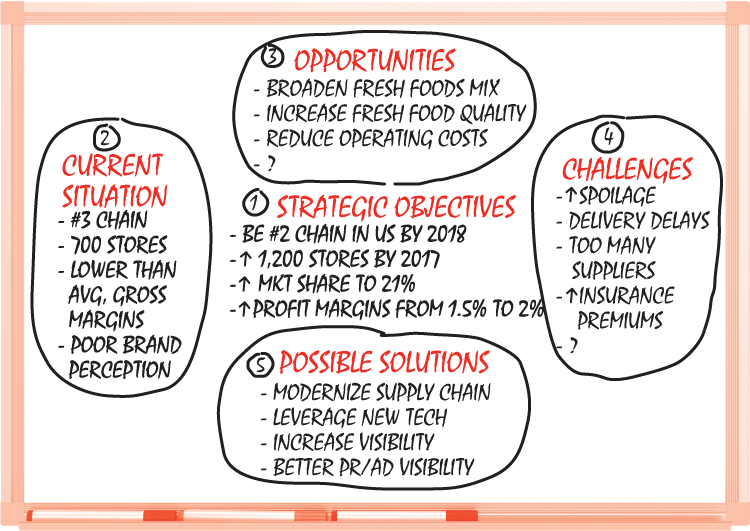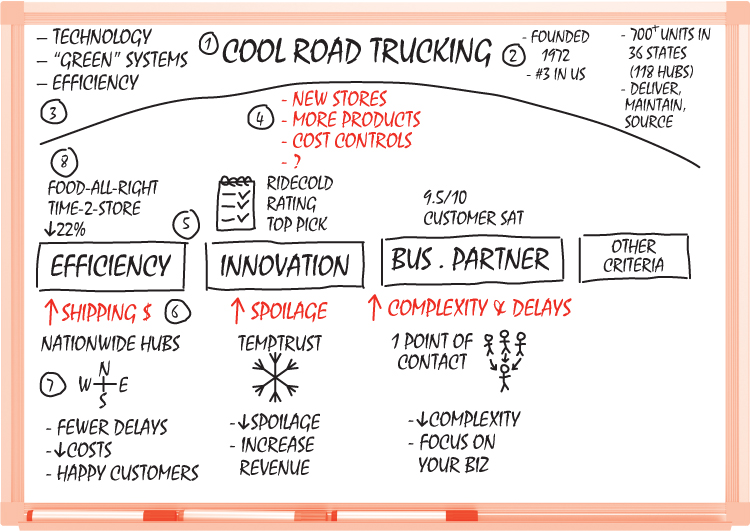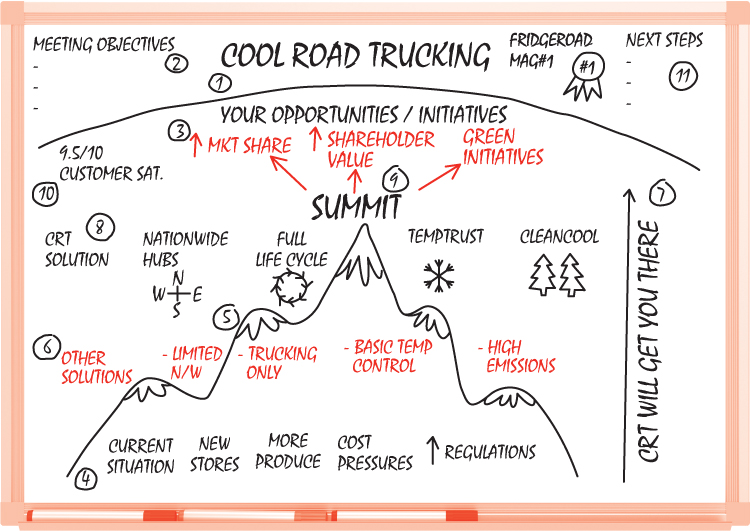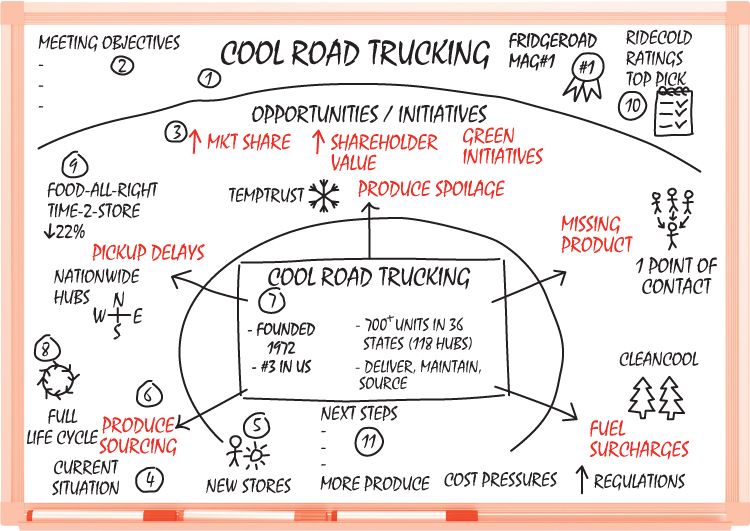Figure 13.1 The Level Set Wheel Whiteboard

Several things make whiteboard selling successful; the approach simplifies complex solutions. The format fosters dynamic group interaction between seller and buyer. PowerPoint is not used. I want you to know this—we use whiteboard selling techniques daily to convey our messages, fill our pipelines, and close business.
—Sales Rep, South Florida
Since 2007—and as of this writing—we have worked with our customers to design and deploy approximately 500 Solution Whiteboards. In some cases, single customers have engaged us to build more than 50 different whiteboards, corresponding to specific products, solutions, or even corporate-level whiteboards that showcase the breadth of solutions that an organization brings to market.
Solution Whiteboards differ from the whiteboards we have showcased so far in a very important way—they talk about the “why you” and “what is it” as opposed to the “why change” and the “why now.” They also can follow a Qualification and Discovery Whiteboard designed to discover and learn more about a prospect's challenges and determine whether the opportunity is worthy of further pursuit.
Many Solution Whiteboards are architected to get into a deeper level of detail about the specific components of your solutions and services and the unique value they deliver. From a content perspective, Solution Whiteboards are driven by the information typically contained in traditional sales collateral (slide presentations, datasheets, whitepapers, etc.). Regardless of the level of detail, Solution Whiteboards are sometimes modeled to represent the journey of the customer or a “day in the life.”
In this section we'll showcase several Solution Whiteboards. Remember, you will want to use situational fluency to do the following four things when presenting solution whiteboards:
One thing you will notice about the Solution Whiteboard examples is that they do not always include all of the whiteboard ingredients we introduced in Chapter 10. You can mix and match the various whiteboard elements as you create your own custom templates tailored to your prospect's unique situation. For example, does your prospect already know the basic facts about your organization? If so, you would probably not want to rehash those in your whiteboard. When it comes to capturing meeting objectives, this is always a good idea, but for the purposes of demonstrating the examples, in some cases there is not enough “real estate” on the pages of this book to include a place for meeting objectives and next steps, which should be included in every whiteboard.
The first example is actually a whiteboard that bridges a Qualification and Discovery Whiteboard and a Solution Whiteboard. You can use this whiteboard in a second meeting as a lead-in to a more detailed Solution Whiteboard. Confirming what you've learned in earlier meetings is a critical step before you communicate value at a deeper level. The Level Set Wheel will help you do just that—achieve a base level of agreement and establish common ground before getting into any more detail about your solutions or services.
Figure 13.1 The Level Set Wheel Whiteboard

ACTIVITY—Develop a Level Set Wheel Whiteboard for a Current Prospect


Let's review each element of the wheel, in the order of how you will draw them. The figure depicts an example of how the Level Set Wheel works when positioning Cool Road Trucking's solutions and services.
Company goals map to your prospect's highest-level business objectives achieved through various initiatives mandated by senior level management and ultimately the CEO and the Board. You will gather this information when doing independent research, during earlier discussions with your prospect, or when using a Qualification and Discovery Whiteboard.
The Current Situation maps to your prospect's current environment, investments, existing systems, and processes.
Opportunities represent what is possible in order to position the business to achieve the corporate objectives and initiatives. Opportunities are more specific than the highest-level corporate objectives. They are specific process and task optimizations, cost/risk reducers, or new product offerings.
Challenges are the specific business issues and concerns that result from the current situation. Challenges are more specific than current situation elements and are what inhibit or prevent your customer from grasping market opportunities and achieving strategic goals and objectives.
Possible solutions are not necessarily the names of your company's specific offerings, but are types of solutions or generic product/solution categories. The idea here is to get the customer to agree they need to do something, and are going to select somebody's solution (not necessarily yours) instead of doing nothing and maintaining the status quo. You should not go into any detail about features and functions at this point—just high-level solution categories or possible strategies.
The Buying Criteria Whiteboard is a good place to start to demonstrate a very simple Solution Whiteboard. It has a straightforward purpose: show how your organization's solutions can uniquely meet your prospect's key buying criteria. This whiteboard is a way to seed the buying criteria in your favor, something that is often difficult. The secret sauce of this whiteboard is that it leverages a customer example and/or proof point to back up how your solution can meet (or drive the need for) each buying criterion. It also saves room for additional buying criteria that are important to your customer. You will note that the buying criteria should be high level and business value oriented, not feature/function, even though your products' or solutions' key capabilities may be what end up satisfying these buying criteria.
You will also note the use of small, numbered “step bubbles.” These serve two functions; one is as a call-out between the whiteboard visual example and the explanation of the purpose of each step, and also to instruct the presenter on the order in which the whiteboard should be drawn.
Figure 13.2 The Buying Criteria Solution Whiteboard

ACTIVITY—Develop a Buying Criteria Solution Whiteboard for a Current Prospect


Let's look at a typical flow of the Buying Criteria Solution Whiteboard, in the following eight steps:
As mentioned previously, find room for meeting objectives and next steps when presenting this whiteboard.
The Mountain is an effective Solution Whiteboard template when you are focused on differentiating your solutions or services from those of your competition, and when you want to align your offerings with the journey your customer wants to take based on their business strategy.
Figure 13.3 The Mountain Solution Whiteboard

ACTIVITY—Develop a Mountain Solution Whiteboard for a Current Prospect


Let's look at the 11 different elements of The Mountain Whiteboard:
The Day-in-the-Life Whiteboard enables you to delve a little bit deeper into a specific solution or product. It also provides an opportunity to showcase the unique capabilities you offer to address real-world customer challenges. You do this by tracking an individual within your prospect's organization, someone who is struggling with their current situation throughout the day. This whiteboard is especially effective in fostering interaction between you and your prospect. It meets the key requirement of positioning you as a thought leader, and will help you confirm your prospect's existing situation.
Figure 13.4 The Day-in-the-Life Solution Whiteboard

ACTIVITY—Complete a Day-in-the-Life Solution Whiteboard for a Current Prospect


Some Solution Whiteboards spend less time reviewing typical trends and challenges. Instead, you will focus more on specific customer issues and how discrete solution elements address them using a story framework. The Day-in-the-Life Solution Whiteboard does this through the following 10 steps.